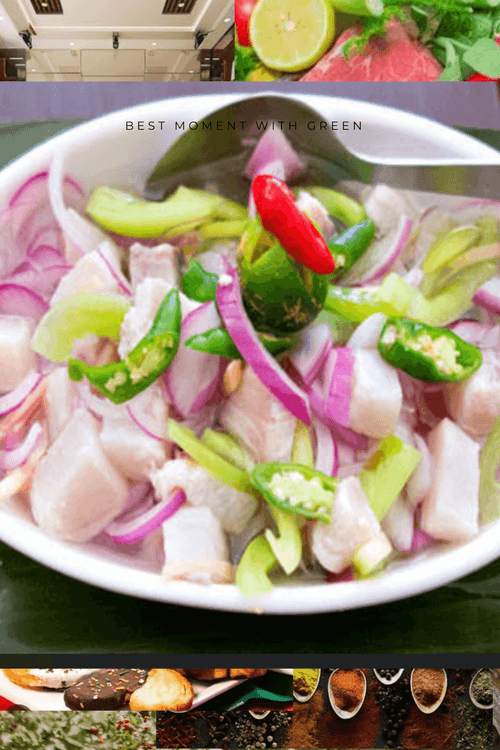A simple and refreshing Filipino ceviche made with fresh fish, vinegar, lime or calamansi juice, and a mix of vegetables.

Stuck mid-recipe?
Chefadora AI has the answer - timers, swaps, step-by-step help.
Ingredients
 fresh fish (like tuna, mackerel, or any firm white fish), diced1lb
fresh fish (like tuna, mackerel, or any firm white fish), diced1lb vinegar (cane vinegar or white vinegar)1/2cup
vinegar (cane vinegar or white vinegar)1/2cup lime or calamansi juice1/2cup
lime or calamansi juice1/2cup small red onion, thinly sliced1piece
small red onion, thinly sliced1piece- Thai chili, sliced1piece
 medium tomato, diced1piece
medium tomato, diced1piece small cucumber, diced (optional)1piece
small cucumber, diced (optional)1piece Salt and pepper to taste
Salt and pepper to taste- Fresh cilantro or green onions for garnish
Want to keep this recipe for later? We can email it to you!
Nutrition (per serving)
Calories
170.0kcal (8.5%)
Protein
35.0g (70%)
Carbs
10.0g (3.64%)
Sugars
2.5g (5%)
Healthy Fat
4.3g
Unhealthy Fat
1.3g
% Daily Value based on a 2000 calorie diet
How to make Kinilaw (Filipino Ceviche)
Prepare the Fish
- Step 1
Make sure the fish is fresh. Dice it into small, bite-sized pieces and place it in a bowl.
Marinate the Fish
- Step 1
Add the vinegar and lime or calamansi juice to the diced fish. Ensure the fish is well-coated in the vinegar mixture. Let it marinate for about 10-15 minutes. The acidity will 'cook' the fish.
Add Vegetables
- Step 1
After marinating, drain a little of the liquid (if desired) and add the sliced red onion, chilies, diced tomato, and cucumber to the bowl.
Season
- Step 1
Season the mixture with salt and pepper to taste. You can adjust the acidity by adding more lime or vinegar if desired.
Garnish
- Step 1
Garnish with fresh cilantro or chopped green onions.
Serve
- Step 1
Serve chilled or at room temperature as an appetizer or side dish.
Want to keep this recipe for later? We can email it to you!
Nutrition (per serving)
Nutrition (per serving)
Calories
170.0kcal (8.5%)
Protein
35.0g (70%)
Carbs
10.0g (3.64%)
Sugars
2.5g (5%)
Healthy Fat
4.3g
Unhealthy Fat
1.3g
% Daily Value based on a 2000 calorie diet
Tips & Tricks
Ensure the fish is very fresh to avoid any foodborne illnesses.
Adjust the amount of chili to suit your spice preference.
FAQS
How do I properly prepare the fish for Kinilaw (Filipino Ceviche)?
To prepare the fish for Kinilaw, ensure you use the freshest fish possible, such as tuna or mackerel. Dice the fish into small, bite-sized pieces and place them in a bowl. Then, add vinegar and lime or calamansi juice to coat the fish thoroughly. Let it marinate for about 10-15 minutes to allow the acidity to 'cook' the fish.
Can I make Kinilaw with frozen fish, and how does it affect the taste?
While it's best to use fresh fish for Kinilaw to achieve the best flavor and texture, you can use previously frozen fish if necessary. Just ensure it is completely thawed and has been handled safely. However, the texture may be slightly different, and the taste might not be as vibrant as with fresh fish.
What are some good substitutions for ingredients in Kinilaw?
If you don't have access to fresh fish, you can substitute with shrimp or scallops, but adjust the marinating time accordingly. For the vinegar, cane vinegar is traditional, but white vinegar works as a substitute. If you can't find calamansi, lime juice is a great alternative. You can also omit the cucumber if you prefer a simpler version.
How should I store leftover Kinilaw, and how long does it last?
Leftover Kinilaw should be stored in an airtight container in the refrigerator. It is best consumed within 1-2 days for optimal freshness. The acidity will continue to 'cook' the fish, so the texture may change slightly over time, but it will still be safe to eat.
What dishes pair well with Kinilaw for a complete meal?
Kinilaw is a refreshing appetizer or side dish that pairs well with grilled meats, such as barbecued chicken or pork. It also complements rice dishes, especially coconut rice or plain steamed rice, and can be served alongside other Filipino dishes like adobo or lumpia for a delightful meal.
Marnirni-apinthi Building, Lot Fourteen,
North Terrace, Adelaide, South Australia, 5000
Australia
